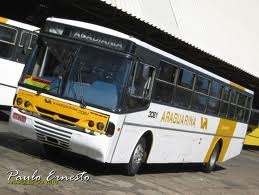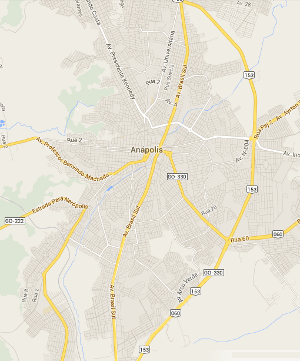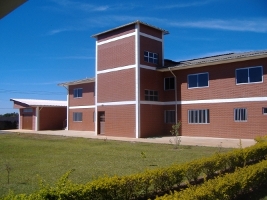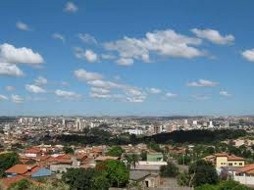Overview

State Flag of Goiás
Anápolis is located just north of the main highway between Brasília—the national capital—and Goiânia, which is the capital of the state of Goiás. In recent years it has grown considerably, expanding past the freeway bypass that runs on the east side of town. It is situated among gently rolling hills, with few trees. It is a modern city, with paved streets, shopping centers, parks and business districts. In recent years the municipal government has done much to improve the infrastructure.
Anápolis is located in the state of Goiás in central Brazil. There are a lot of historic towns in the state, and the Federal District (the Brazilian equivalent of the District of Columbia, where Brasília is) was carved out of the state back in the mid 1900's. The entire region uses 220-volt electricity instead of 110-volt, which is used in most of the rest of the country. This use of different voltages has been known to cause problems. Fortunately, much equipment these days is universal, meaning it can handle anything from 100 to 240 volts.
Anápolis—and Goiás in general—is known for a type of food called pamonha. Pamonhas come in two main varieties, sweet and salty, and are made from corn. They are very tasty; my personal preference is for the salty kind. You can find pamonharias—a restaurant that specializes in pamonha—all over the city.
Overall, it is not a bad place to live—for those who like city life. But even those who do not can enjoy the benefits of cheap public transportation and the availability of two nearby larger cities to visit for serious shopping and other necessities of life.
Climate
The central part of Brazil, which includes Brasília and surrounding regions, is located at somewhat higher elevation than most of the country. As a result, temperatures are noticeably cooler than one would expect for the latitude. Anápolis is slightly lower than Brasília and thus a bit warmer, but still reasonably comfortable. Compared with the blast furnace of Cuiabá or the steam bath of Porto Velho, Anápolis is a haven of cool breezes.
As for seasons, even though the words exist and are used, most people do not think in terms of summer and winter. Rather, they think in terms of Rainy Season and Dry Season. Rainy Season is just that: rainy. Think “thunderstorms”. At times, very heavy storms, with a lot of lightning. Lightning protection for electronic equipment is a fact of life. And wet. Before the city government paved the remaining dirt roads, they would become almost impassable by the end of Rainy Season, with ruts almost the size of small creeks. And things get green. You have to cut grass regularly.
Nevertheless, there are periods where the rain is merely constant and drizzly, without lightning and thunder. These periods usually occur around Christmas or early January. Sometimes it will do this for nearly two weeks at a time. Nothing dries. But after a while, the aftenoon-thunderstorm pattern returns. At the height of Rainy Season, it is nearly impossible to envision Dry Season.
Dry Season varies from year to year, depending on the weather patterns. Some years, Dry Season means day after day of blue sky, without a cloud from dawn to dusk. Once in a while a cold front will pass through, but surprisingly, in spite of the cooler overall climate, cold fronts do not drop temperatures as much as they do in Cuiabá. During the really dry years, these fronts are the only times when you see clouds. Occasionally, they will drop a bit of rain.
Other years, when the circulation is different, the weather is more like Rainy Season, only with much less rain. Cold fronts bring more rain than during truly dry years. These years are actually more common. Either way, the grass turns brown. Things turn dusty. At the height of Dry Season it is nearly impossible to envision Rainy Season.
Transportation

Anápolis is a modern city, with plenty of vehicle traffic. Cars, trucks, motorcycles. Plenty of motorcycles. They are a cheap means of transportation and much more popular than in the States. In fact, the traffic has gotten so heavy in recent years that the city government has undertaken major construction projects at a couple of the busiest intersections, turning the main avenue in each into a through-way with exits to an overhead traffic circle for the other streets.
Another project that the city government has undertaken in recent years is Asfalto para Todos (Pavement for Everyone); a project to pave the outlying neighborhoods that still had dirt roads. This has made a big difference, especially during Rainy Season as described above, when dirt roads turn into riverbeds.
Public transportation is also popular. The city bus system is better than you will find in most American cities. Of course, this is true of most Brazilian cities. In Anápolis, all buses begin and end their routes in the central terminal. You can enter the terminal either on a bus—having already paid the fare—and transfer to another bus for free, or you can walk in and pay the equivalent of one bus fare at the gate. Essentially, you can get pretty much anywhere in town and back for the price of two bus fares.
A mid-sized rodoviária, or interurban bus station, provides service to a number of cities. To get to places not on the list of destinations, travelers must first go somewhere such as Brasília or Goiânia, and from there take a different bus to their destination of choice. Since Goiânia is the state capital and very close and a popular destination, buses leave for it every 20 minutes, for a very reasonable fare.
Anápolis does not have a commercial passenger airport, so if you wish to fly, you will need to go to either Brasília or Goiânia. There is an airport, but it is used for private aviation.
Shopping and Services

Map of Anápolis
There are a couple of supermarket chains with at least one store in Anápolis. In addition, there are a number of local markets, plus many neighborhood grocery stores. A person can find everything they need for day-to-day cooking, plus a few “extras” such as the occasional jar of jalapeño peppers and powdered guaraná. Usually, the local and neighborhood stores have the best fruits and vegetables. Carrefour—an international chain based in France—usually has the lowest prices, but the worst fruits and vegetables. In addition, they have a lot of non-food items.
In addition to the downtown area, there are a lot of local business districts all over town, where you can buy a lot of basic necessities, although the prices are usually higher and the choices fewer.
Nevertheless, there are still a number of items that are hard or impossible to find. This is largely because of the proximity of Goiânia and Brasília. Buses leave for Goiânia every 20 minutes for a fare of just over twice the standard city bus fare, and make travel there easy. What you can't get in Anápolis, you can usually get in Goiânia. This has reduced the incentive for business owners to provide certain items locally. However, the city is continuing to grow, and some people predict that within the next 10 to 20 years, Anápolis will have basically as much available as any other large city.
Phone service is pretty good. In addition to Oi, which is the descendant of what was once the nationalized monopoly and now competes as a private company, there are a couple of other major providers. Cell phones are very common and service is also pretty good; many people do not even see the need to have a fixed line and just use a cell phone.
The phone companies also offer Internet service. In addition, one is a cable company that also offers cable TV, though it hasn't arrived in every neighborhood yet. And there are radio Internet providers, where they mount a special antenna outside the house and run an ethernet cable in to your computer or router. These are useful in areas where the better wired providers have not yet arrived. Overall, service continues to improve and costs are going down, as new technology makes access faster and cheaper.
Water and electricity are reasonably reliable, although Dry Season often puts a strain on water supply, and Rainy Season, with its wind and thunderstorms, often causes power outages. To be fair, this is not really any different than in many places in the U.S.
SIL Presence and Activity

SIL Office in Anápolis
SIL has long had an indirect connection with Anápolis because of the presence of partner organizations in the city. But it was only in 2008 that SIL Brazil officially moved its headquarters from Cuiabá to here, using facilities rented from Missão Novas Tribos do Brasil. This office is located in the northeastern part of the city, in the bairro (neighborhood) of Cidade Universitária. Only two blocks from the major artery of Avenida Brasil, there is fairly easy access to the rest of the city, as well as the freeway, which is only about a kilometer north of the office. An evangelical university sits on the opposite side of Avenida Brasil, and some members of New Tribes Mission of Brazil live on the same street. A fair bit of development has taken place since SIL moved here in 2008, including the once vacant area to the east, where an entire new subdivision has been built.
For more information regarding the move from Cuiabá to Anápolis, here are a couple of related work trip reports.
The Anápolis office is our administrative headquarters in Brazil. Its main purpose is to coordinate and facilitate the work of translation teams working throughout the country, as well as interface with partner organizations. In order to fulfill that purpose, there are offices for the directorate, accounting, scripture use, vernacular media services, graphics and computer support. In addition, we have a small linguistic library and a collection of vernacular material. There are also a kitchen and meeting room for social activities. This is all within one building, whereas before, when we had our center in Cuiabá, these functions each had their own building.
This building is a single two-story structure located at the end of the street, two blocks from Avenida Brasil. In addition, SIL constructed a storage deposit next to the main building. As with nearly all structures in Brazil, this mini-complex is surrounded by a wall, for security. Four phone lines come into the building; one for FAX, the other three for phone and Internet. In addition to the regular phone lines, the office has two VoIP lines. One is a U.S. line, with calling capabilities in the U.S. and 34 other countries, including Brazil, for one low monthly fee. The other is a Brazilian line, with similar features, but only works in-country. As added protection against power failures, the building has its own transformer connected to the main high-voltage lines.
A centralized data network provides connectivity for office computers and the internal VoIP phone system.
The Anápolis office differs from SIL translation centers in another respect; instead of providing housing for members, here everyone has his or her own home in town. Some live fairly close, within easy walking distance, while others live further and have to either drive or else take the bus. At first, approximately half of the members lived in the small town of Vianópolis, about 50 kilometers away, where there was a New Tribes mission school for their children. However, after the last of their kids graduated, the remaining families moved up to Anápolis and now live here with everyone else.
These days SIL provides considerably less direct support than back in the earlier days of large, full-service translation centers. The reason is that today just about every service needed can be found locally. The world is modernizing everywhere; this is not merely a local trend in Brazil. And it is necessary for SIL to adapt organizational methods to reflect the changing times, without losing sight of the real goals.
Area Tourism
Anápolis itself actually has very little in the way of sightseeing to offer tourists. Most visitors come either to visit family or friends, or else for some type of business- or education-related purpose. However, there are plenty of places in the region that are definitely worth visiting. For those who like the outdoors or visiting historical sites, Pirenópolis is less than an hour away to the north. The state of Goiás is full of history; there are many old towns that draw plenty of tourists every year. Many people come to experience Goiás' unique culinary offerings. And the Distrito Federal, or Federal District, is completely contained within Goiás, for those who wish to visit the national capital.




